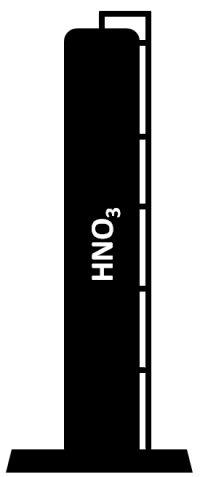meta data for this page
2.B.2 - Nitric Acid Production
Short description
| Category Code | Method | AD | EF | ||||||||||||
|---|---|---|---|---|---|---|---|---|---|---|---|---|---|---|---|
| 2.B.2 | T2 | PS | D | ||||||||||||
| NOx | NMVOC | SO2 | NH3 | PM2.5 | PM10 | TSP | BC | CO | Pb | Cd | Hg | Diox | PAH | HCB | |
| Key Category: | -/- | - | - | - | - | - | - | - | - | - | - | - | - | - | - |
During the production of nitric acid (HNO3), nitrogen oxide is produced unintentionally in a secondary reaction during the catalytic oxidation of ammonia (NH3). HNO3 production occurs in two process stages:
- Oxidation of NH3 to NO and
- Conversion of NO to NO2 and absorption in H2O.
Details of the process are outlined below:

Catalytic oxidation of ammonia
A mixture of ammonia and air at a ratio of 1:9 is oxidised, in the presence of a platinum catalyst alloyed with rhodium and/or palladium, at a temperature of between 800 and 950 °C. The reaction according to the Oswald process is as follows:
4 NH3 + 5 O2 –> 4 NO + 6 H2O
Simultaneously, nitrogen, nitrous oxide and water are formed by the following undesired secondary reactions:
4 NH3 + 3 O2 –> 2 N2 + 6 H2O
4 NH3 + 4 O2 –> 2 N2O + 6 H2O
All three oxidation reactions are exothermic. Heat may be recovered to produce steam for the process and for export to other plants and/or to preheat the residual gas. The reaction water is condensed in a cooling condenser, during the cooling of the reaction gases, and is then conveyed into the absorption column.
Method
In Germany, there are currently nine nitric acid plants.
Activity data
As this source category is a key category for N2O, plant specific activity data is collected here according to the IPCC guidelines.
This data is made available basically via a co-operation agreement with the nitric acid producers and the IVA (Industrieverband Agrar). As the data provided by the producers has to be treated as confidential, it is anonymised by the IVA before submitting it to the UBA. However, one producer is delivering its data directly to the UBA. After checking this specific data, it is merged with that provided by the IVA.
According to the IVA, catalytic reduction is used as an abatement method in some of the plants.
Emission factors
Different T2 default NOx emission factors based on different technology types and abatement systems are used from the EEA Emission Inventory Guidebook 2019 (EF for medium and high pressure processes and for catalytic reduction of low, medium and high pressure process)1). The applied emissions factors are listed in Table 1.
Table 1: Tier 2 emission factor of NOx for source category 2.B.2 Nitric acid production
| Emission factor (kg/t) | Process |
|---|---|
| 7.5 | medium pressure process |
| 3 | high pressure process |
| 0.4 | low, medium and high pressure process, catalytic reduction |
Recalculations
With emission factors revised for each plant, recalculations of NOx have been carried out compared to last year's submission. So far a T1 method with a T1 Default EF was used. With the sabmissionsubmission 2022 a T2 method is applied with T2 EFs. The total emissions from 1990 to 2019 for the latest two submissions and their difference are listed in Table 2.
Table 2: NOx emissions from nitric acid production
| Submission 2022 | Submission 2021 | Difference | |
|---|---|---|---|
| Year | NOₓ emission (in kt) | NOₓ emission (in kt) | NOₓ emission (in kt) |
| 1990 | 11.30 | 16.98 | 5.68 |
| 1991 | 10.40 | 15.60 | 5.20 |
| 1992 | 10.08 | 14.76 | 4.69 |
| 1993 | 9.60 | 14.76 | 5.17 |
| 1994 | 9.45 | 14.59 | 5.14 |
| 1995 | 10.33 | 16.25 | 5.91 |
| 1996 | 10.65 | 16.60 | 5.95 |
| 1997 | 10.50 | 16.33 | 5.83 |
| 1998 | 10.55 | 16.54 | 5.99 |
| 1999 | 10.94 | 17.40 | 6.46 |
| 2000 | 11.93 | 19.23 | 7.30 |
| 2001 | 11.24 | 18.07 | 6.83 |
| 2002 | 14.05 | 21.12 | 7.07 |
| 2003 | 14.67 | 22.49 | 7.82 |
| 2004 | 17.59 | 25.99 | 8.40 |
| 2005 | 17.92 | 26.34 | 8.43 |
| 2006 | 18.26 | 26.95 | 8.69 |
| 2007 | 14.28 | 28.79 | 14.50 |
| 2008 | 12.91 | 26.30 | 13.39 |
| 2009 | 2.78 | 22.58 | 19.81 |
| 2010 | 1.01 | 25.25 | 24.24 |
| 2011 | 0.99 | 24.85 | 23.85 |
| 2012 | 1.00 | 24.90 | 23.90 |
| 2013 | 1.03 | 25.72 | 24.69 |
| 2014 | 1.04 | 26.01 | 24.97 |
| 2015 | 1.01 | 25.22 | 24.21 |
| 2016 | 1.02 | 25.41 | 24.39 |
| 2017 | 1.08 | 27.11 | 26.03 |
| 2018 | 1.07 | 26.69 | 25.62 |
| 2019 | 1.07 | 26.69 | 25.62 |
For pollutant-specific information on recalculated emission estimates for Base Year and 2019, please see the pollutant specific recalculation tables following chapter 8.1 - Recalculations.
Planned improvements
No category-specific improvements are planned.

